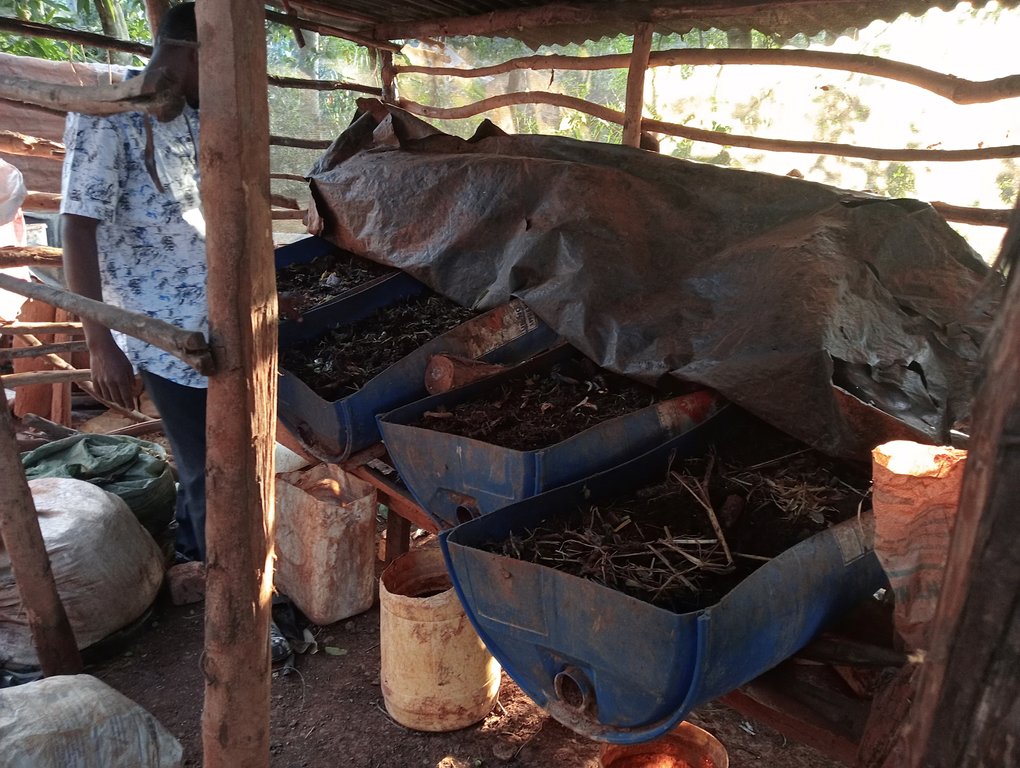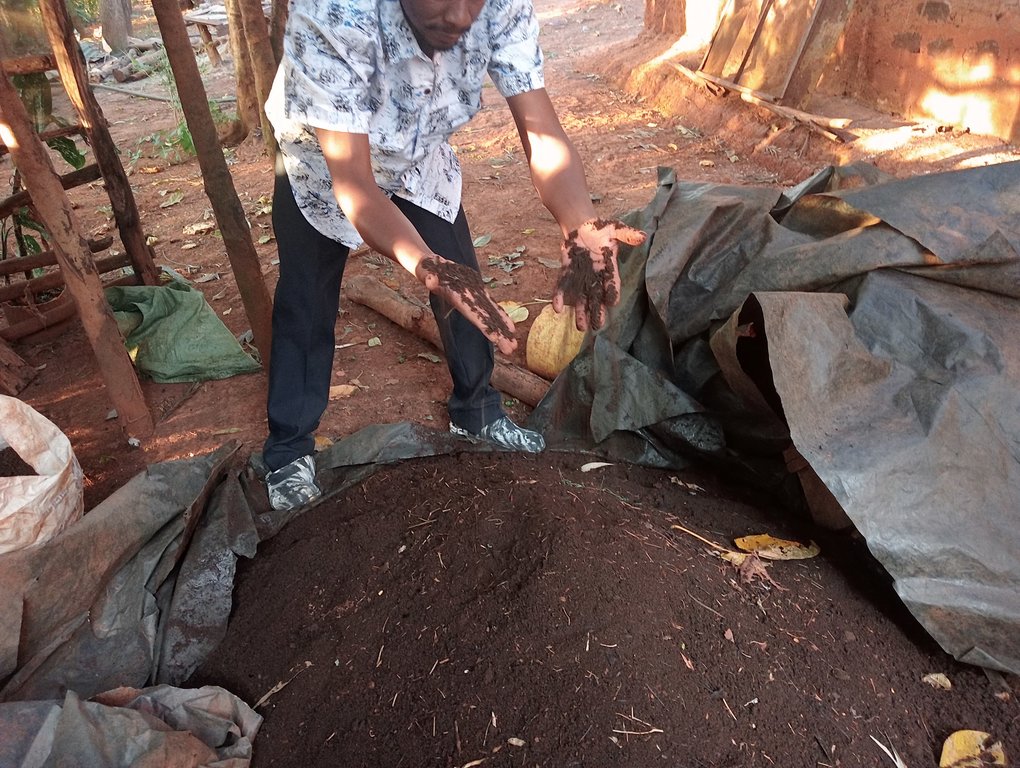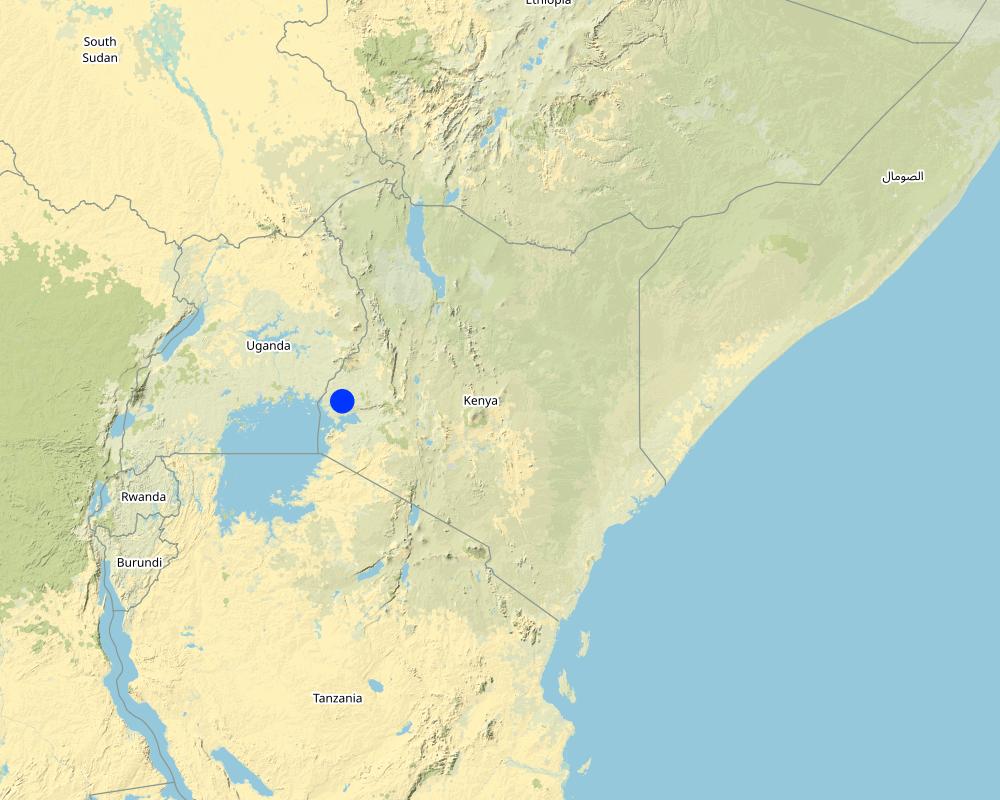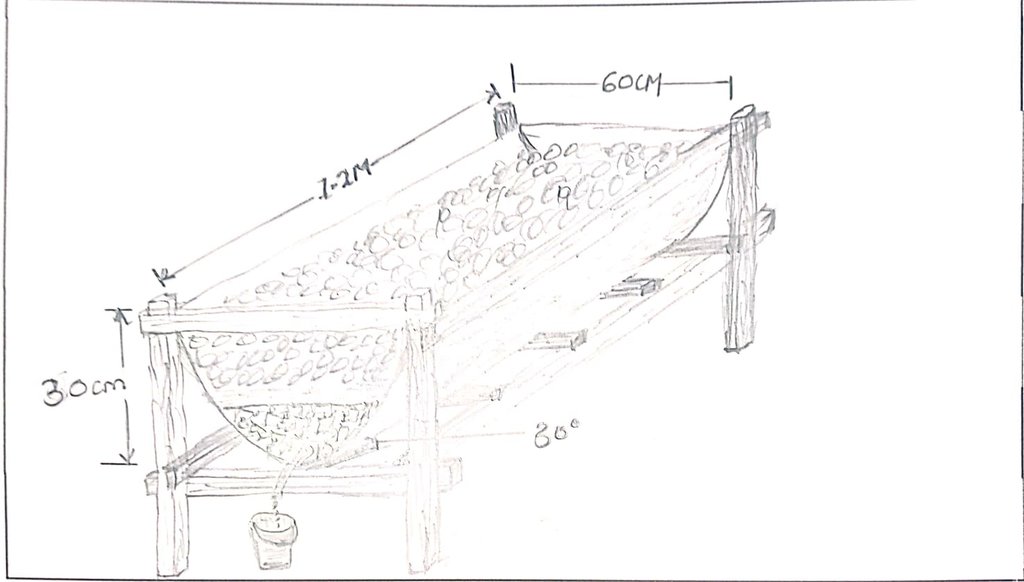Vermicomposting: an effective liquid fertilizer and biopesticide [肯尼亚]
- 创建:
- 更新:
- 编制者: William Akwanyi
- 编辑者: George Onyango, Innocent Faith, Noel Templer
- 审查者: William Critchley, Rima Mekdaschi Studer
technologies_6685 - 肯尼亚
查看章节
全部展开 全部收起1. 一般信息
1.2 参与该技术评估和文件编制的资源人员和机构的联系方式
关键资源人
土地使用者:
Mururi Wamunga Job
Welthungerhilfe farmer
肯尼亚
SLM专业人员:
SLM专业人员:
有助于对技术进行记录/评估的项目名称(如相关)
Soil protection and rehabilitation for food security (ProSo(i)l)有助于对技术进行记录/评估的机构名称(如相关)
Deutsche Gesellschaft für Internationale Zusammenarbeit (GIZ)有助于对技术进行记录/评估的机构名称(如相关)
Alliance Bioversity and International Center for Tropical Agriculture (Alliance Bioversity-CIAT) - 肯尼亚1.3 关于使用通过WOCAT记录的数据的条件
编制者和关键资源人员接受有关使用通过WOCAT记录数据的条件。:
是
1.4 所述技术的可持续性声明
这里所描述的技术在土地退化方面是否存在问题,导致无法被认为是一种可持续的土地管理技术?:
否
注释:
Farmers who have used vermicompost and vermijuice have recorded good harvests and there are no adverse impacts on their farms.
1.5 参考关于SLM方法(使用WOCAT记录的SLM方法)的调查问卷
2. SLM技术的说明
2.1 技术简介
技术定义:
Vermicomposting is an on-farm waste management strategy where worms are used for biodecomposition of wastes to produce a natural liquid fertilizer and pesticide.
2.2 技术的详细说明
说明:
Vermitechnology is biodecomposition of wastes using worms such as red wigglers. It includes vermicomposting (production of compost) and vermiculture (production of worms to ensure sustainability of the enterprise).
A vermicomposting structure is installed under shade and covered with a black polythene sheet to protect worms from the heat of the sun, and to prevent volatilization of nitrogen. The structure itself can be made by cutting a 60 cm radius and 120 cm height drum into two halves lengthwise. The half to be used must be thoroughly cleaned of oil or chemical residue. A hole is drilled at one end of the half drum for the installation of a tap. A base is made using wooden rails fastened on wooden posts using nails. The container is angled at 30° with the outlet pipe or tap on the lower side to allow free flow of leachate/ vermijuice. Materials are introduced in the half drum, including a gunny sheet covering the entire inside surface and ends hanging outside on the edges of the drum, a 7 cm layer of small stones followed by a 0.5 cm layer of sand on the stones, 10 cm layer of bedding materials on the sand, and 10 cm layer of worm food (kitchen and/ or animal wastes) on the bedding material. 20 litres of water are evenly sprinkled on the worm food. The worms and casts are introduced and evenly spread on the food. A bucket is placed at the outlet to collect drops of vermijuice.
Bedding materials include maize cobs, chopped maize straw, agroforestry tree bark, husks, old cartons and paper, and sugarcane bagasse. Temperature and humidity are checked by a thermometer and a hydrometer respectively. However, temperature can be checked by hand also. It is advisable that food (waste) is decomposed before being added onto the bedding material to maintain the temperature within the desired range of 15 - 20°C. Worms coil at the top of the material whenever temperatures go higher. Humidity is often higher in culture bins than in composting beds. Hence, more leachate in culture bins than in composting beds. However, humidity content in both culture bins and composting beds should not exceed 60% since the worms can take in a lot of water and die.
Feeding of the worms is done every 2 weeks where a mixture of 1 kg of chopped fresh tithonia, 3 kg of fresh cow dung, and 3 kg of cooked maize meal (“ugali”) is added and evenly spread on the decomposing material. Collected juice is returned to the system every 2 weeks for a period of 2 months. After the 2 months, the juice will be ready for use as folia fertilizer and pesticide. The casts become ready manure after about 2.5 - 3 weeks. It is harvested by dividing the container into 2 equal halves widthwise and not introducing food to the upper half to make the worms concentrate on materials on the lower half. The worm-free compost on the upper part is completely removed to be used as manure. The remaining material containing the worms is spread uniformly in the half drum. Worm food is then added evenly spread on top.
The system described above produces about 30 kg of ready-to-use compost and about 10 litres of vermijuice in 3 months. Provided that all inputs are available, a farmer can produce vermicompost and vermijuice 4 times from the same system in a year i.e., 40 litres of vermijuice and 120 kgs of ready-to-use compost in a year. Normally, a one-acre (0.4ha) farm requires about 20 tonnes of compost for planting maize. Vermijuice is mixed with water in the ratio of 1 part of vermijuice to 10 parts of water when required as a folia fertilizer and in the ratio of 1 part of vermijuice to 5 parts of water when required as a pesticide. 20 – 30 litres of vermijuice can be applied to a 0.4 ha farm. However, the amount required for fertilizer varies from farm to farm depending on the conditions of the soil and the crop(s) to be grown. It is important that soil testing is done to determine the conditions of the soil to ensure that the compost is added at the correct rate.
Vermicomposting requires less space and less maintenance labour compared to normal composting. It takes a shorter time to get compost from vermicomposting than from normal composting. On the other hand, large farms would require the installation of several vermicomposting units in order to meet the farm demand. The choice of either technology or both depends on a number of factors, including the size of the farm, the amount of compost required, the time required to produce the compost, etc.
2.3 技术照片
2.5 已应用该技术的、本评估所涵盖的国家/地区/地点
国家:
肯尼亚
区域/州/省:
Kakamega County in western Kenya
有关地点的进一步说明:
Matora A Village, Ebukuti Sub-location, Manyala Location, Marama South Ward, Butere Sub-county
具体说明该技术的分布:
- 适用于特定场所/集中在较小区域
技术现场是否位于永久保护区?:
否
注释:
The are no protected areas within the area i.e., sub-county
Map
×2.6 实施日期
注明实施年份:
2017
2.7 技术介绍
详细说明该技术是如何引入的:
- 通过项目/外部干预
注释(项目类型等):
ProSoil project under WHH as the implementing partner
3. SLM技术的分类
3.1 该技术的主要目的
- 改良生产
- 创造有益的经济影响
3.2 应用该技术的当前土地利用类型
同一土地单元内混合使用的土地::
是
具体说明混合土地使用(作物/放牧/树木):
- 农林牧业

农田
- 一年一作
- 多年一作(非木材)
- 乔木与灌木的种植
年作 - 具体指明作物:
- 谷物类 - 玉米
- 豆科牧草和豆类 - 豆子
- 根/块茎作物 - 红薯、山药、芋头/椰子,其他
- 蔬菜 - 叶菜(色拉、卷心菜、菠菜和其他)
- 蔬菜 - 其他
年作制度:
玉米/高粱/谷子与豆类间作
多年生(非木质)作物 - 指定作物:
- 香蕉/芭蕉/蕉麻
- 饲料作物 - 草
- passiflora - passion fruit, maracuja
乔木和灌木种植 - 指定作物:
- 鳄梨
- 水果、其他
- 芒果、山竹果、番石榴
- 木瓜
每年的生长季节数:
- 2
具体说明:
Crops planted during long and short rain seasons.
采用间作制度了吗?:
是
如果是,说明哪些作物是间作的:
Maize and beans
采用轮作制度了吗?:
是
如果是,请具体说明:
Some sections of the farm are left fallow during the short rains to allow for soil regeneration.

牧场
集约放牧/饲料生产:
- 改良牧场
动物类型:
- cattle - dairy and beef (e.g. zebu)
- 山羊
- 家禽
是否实行作物与牲畜的综合管理?:
是
如果是,请具体说明:
Cattle dung and poultry droppings are used as inputs in vermicomposting. Compost is applied on soil where livestock fodder is planted.
产品和服务:
- economic security, investment prestige
- 蛋类
- 肉类
- 奶类
品种:
cattle - dairy and beef (e.g. zebu)
计数:
2
品种:
山羊
计数:
3
品种:
家禽
计数:
4
注释:
There are assorted trees on the farm, and these provide litter that is an input in composting.
3.3 由于技术的实施,土地使用是否发生了变化?
由于技术的实施,土地使用是否发生了变化?:
- 否(继续问题3.4)
3.4 供水
该技术所应用土地的供水:
- 混合雨水灌溉
注释:
Crops are planted all year round due to availability of irrigation water from Eshiatukha and Luanda streams which supplement rain water.
3.5 该技术所属的SLM组
- 土壤肥力综合管理
- 病虫害综合管理(包括有机农业)
- 废物管理/废水管理
3.6 包含该技术的可持续土地管理措施

农艺措施
- A2:有机质/土壤肥力
- A6:残株管理
A6:对残株管理作出具体说明:
A 6.3:收集
注释:
Some plant residues, especially leaves are collected and used as input in vermicomposting.
3.7 该技术强调的主要土地退化类型

化学性土壤退化
- Cn:肥力下降和有机质含量下降(非侵蚀所致)
- Ca:酸化
- Cp:土壤污染
- Cs:盐化/碱化

生物性退化
- Bp:害虫/疾病增加,捕食者减少
注释:
Compost and vermijuice stabilize soil pH and have potential to suppress some soil-born plant pathogens that would have caused plant diseases.
3.8 防止、减少或恢复土地退化
具体数量名该技术与土地退化有关的目标:
- 防止土地退化
- 减少土地退化
注释:
Prevents pathogens
4. 技术规范、实施活动、投入和成本
4.1 该技术的技术图纸
技术规范(与技术图纸相关):
The drawing above is of a half drum; 60 cm radius and 120 cm height.
The half drum is supported on rails fastened on wooden posts using nails.
The half drum is positioned in a slanting manner at 30° to the horizontal level to enable free flow of the juice.
The outlet of the vermijuice is on the lower side.
Materials introduced in the half drum include the following: a gunny sheet covering the entire inside surface and ends hanging outside on the edges of the drum; 7 cm layer of small stones followed by a 0.5 cm layer of sand on the stones, 10 cm layer of bedding materials on the sand, and 10 cm layer of worm food on the bedding material. The worm food material are determined by the required soil nutrients e.g., banana trunk for potassium (K)-rich manure and/ or vermijuice, crushed eggs for calcium (Ca)-rich, and tithonia for nitrogen (N)-rich.
The worms and cast are introduced and evenly spread on the food.
A bucket is placed at the outlet to receive dropping vermijuice.
作者:
William Akwanyi
日期:
30/01/2023
4.2 有关投入和成本计算的一般信息
具体说明成本和投入是如何计算的:
- 每个技术单元
指定单位:
A half drum vermicomposting unit as described in 2.2
指定单位面积(如相关):
0.17 cubic metres
其它/国家货币(具体说明):
KES
如相关,注明美元与当地货币的汇率(例如1美元=79.9巴西雷亚尔):1美元=:
122.95
注明雇用劳工的每日平均工资成本:
300
4.3 技术建立活动
| 活动 | 时间(季度) | |
|---|---|---|
| 1. | Construction of vermicomposting unit, inclusive shed | Before procuring worms |
| 2. | Adding materials | Before procuring worms |
| 3. | Introduction of worms | After completion of construction |
注释:
The system described above produces about 30 kg of ready-to-use compost and about 10 litres of vermijuice in 3 months. The farmer should have the structure ready with all materials except food for the worms before procuring the worms.
4.4 技术建立所需要的费用和投入
| 对投入进行具体说明 | 单位 | 数量 | 单位成本 | 每项投入的总成本 | 土地使用者承担的成本% | |
|---|---|---|---|---|---|---|
| 劳动力 | Construction of the vermicomposting structure | |||||
| 劳动力 | Construction of shade over the vermicomposting structure | |||||
| 设备 | Hammer | |||||
| 设备 | Hand saw | |||||
| 设备 | Tape measure | |||||
| 植物材料 | Bedding material | |||||
| 肥料和杀菌剂 | Worms in cast | |||||
| 肥料和杀菌剂 | Kitchen or animal wastes | |||||
| 施工材料 | Half drum | |||||
| 施工材料 | Gunny sheet | |||||
| 施工材料 | Nails | |||||
| 施工材料 | Iron sheets | |||||
| 其它 | Gravel | |||||
| 其它 | Sand | |||||
| 其它 | Water |
如果您无法分解上表中的成本,请估算建立该技术所需要的总成本。:
7000.0
如果土地使用者负担的费用少于100%,请注明由谁负担其余费用:
The ProSoil project provided the worms
注释:
The farmer was unable to break down the costs of the listed items. The costs refer to the equipment described in 2.2. The cost is in Ksh/ KES equivalent to 56.93 USD.
4.5 维护/经常性活动
| 活动 | 时间/频率 | |
|---|---|---|
| 1. | Monitoring humidity and temperature | Daily |
| 2. | Feeding | Biweekly |
| 3. | Watering | Biweekly |
| 4. | Predator control | Daily |
| 5. | Harvesting compost | Every 2.5 - 3 months |
| 6. | Collection of vermijuice | Daily |
注释:
Temperature and humidity are checked by a thermometer and a hydrometer respectively.
4.6 维护/经常性活动所需要的费用和投入(每年)
如果您无法分解上表中的成本,请估算维护该技术所需要的总成本。:
2000.0
注释:
The farmer was unable to break down the costs of the listed items. The cost is in Ksh/ KES equivalent to 16.27 USD.
4.7 影响成本的最重要因素
描述影响成本的最决定性因素:
Rate of man-days vary from one place to another. It is not easy to attach monetary value to some of the input e.g., wastes and water.
Exchange rate for January 2023, source: European Commission/ InfoEuro online at https://commission.europa.eu/funding-tenders/procedures-guidelines-tenders/information-contractors-and-beneficiaries/exchange-rate-inforeuro_en
5. 自然和人文环境
5.1 气候
年降雨量
- < 250毫米
- 251-500毫米
- 501-750毫米
- 751-1,000毫米
- 1,001-1,500毫米
- 1,501-2,000毫米
- 2,001-3,000毫米
- 3,001-4,000毫米
- > 4,000毫米
指定年平均降雨量(若已知),单位为mm:
1300.00
有关降雨的规范/注释:
Monthly rainfall variability is high with some months such as January recording less than 5 mm of total rainfall.
注明所考虑的参考气象站名称:
Kakamega Meteorological Station
农业气候带
- 潮湿的
The climate in the area favours most agricultural activities.
5.2 地形
平均坡度:
- 水平(0-2%)
- 缓降(3-5%)
- 平缓(6-10%)
- 滚坡(11-15%)
- 崎岖(16-30%)
- 陡峭(31-60%)
- 非常陡峭(>60%)
地形:
- 高原/平原
- 山脊
- 山坡
- 山地斜坡
- 麓坡
- 谷底
垂直分布带:
- 0-100 m a.s.l.
- 101-500 m a.s.l.
- 501-1,000 m a.s.l.
- 1,001-1,500 m a.s.l.
- 1,501-2,000 m a.s.l.
- 2,001-2,500 m a.s.l.
- 2,501-3,000 m a.s.l.
- 3,001-4,000 m a.s.l.
- > 4,000 m a.s.l.
说明该技术是否专门应用于:
- 不相关
关于地形的注释和进一步规范:
The farm is located at an area that is lower in altitude compared to other areas in the larger area. The altitude of the farm is 1,319 meters above sea level.
5.3 土壤
平均土层深度:
- 非常浅(0-20厘米)
- 浅(21-50厘米)
- 中等深度(51-80厘米)
- 深(81-120厘米)
- 非常深(> 120厘米)
土壤质地(表土):
- 中粒(壤土、粉土)
土壤质地(地表以下> 20厘米):
- 粗粒/轻(砂质)
表土有机质:
- 中(1-3%)
如有可能,附上完整的土壤描述或具体说明可用的信息,例如土壤类型、土壤酸碱度、阳离子交换能力、氮、盐度等。:
Soil pH of most farms in the area ranges from moderately acid (4) to moderately alkaline (7).
5.4 水资源可用性和质量
地下水位表:
5-50米
地表水的可用性:
好
水质(未处理):
不良饮用水(需要处理)
水质请参考::
地下水和地表水
水的盐度有问题吗?:
否
该区域正在发生洪水吗?:
否
关于水质和水量的注释和进一步规范:
There are several boreholes in the area and according to interviews with some borehole owners, the depts are not more than 50 metres.
5.5 生物多样性
物种多样性:
- 中等
栖息地多样性:
- 中等
关于生物多样性的注释和进一步规范:
The area has high agrobiodiversity since most farms are under crops and trees.
5.6 应用该技术的土地使用者的特征
定栖或游牧:
- 半游牧的
生产系统的市场定位:
- 混合(生计/商业)
非农收入:
- > 收入的50%
相对财富水平:
- 平均水平
个人或集体:
- 个人/家庭
机械化水平:
- 手工作业
性别:
- 女人
- 男人
土地使用者的年龄:
- 中年人
- 老年人
说明土地使用者的其他有关特征:
The farmer uses the land together with his other family members.
5.7 应用该技术的土地使用者使用的平均土地面积
- < 0.5 公顷
- 0.5-1 公顷
- 1-2 公顷
- 2-5公顷
- 5-15公顷
- 15-50公顷
- 50-100公顷
- 100-500公顷
- 500-1,000公顷
- 1,000-10,000公顷
- > 10,000公顷
这被认为是小规模、中规模还是大规模的(参照当地实际情况)?:
- 中等规模的
注释:
Farmers with more than 2 ha in the area are considered to have large pieces of land since there is high level of land fragmentation in the area.
5.8 土地所有权、土地使用权和水使用权
土地所有权:
- 个人,有命名
土地使用权:
- 租赁
- 个人
用水权:
- 自由进入(无组织)
土地使用权是否基于传统的法律制度?:
否
具体说明:
Each landowner has full control of the way he/ she wants to use his/ her land.
注释:
The farmer has an official title deed for his piece of land. He also leases other people's pieces of land for farming. Water in the streams such as Eshiatukha and Luanda and springs is freely accessed without restrictions. There is a borehole in the neighbourhood, and the managers of this borehole have set rules for accessing the water thereat.
5.9 进入服务和基础设施的通道
健康:
- 贫瘠
- 适度的
- 好
教育:
- 贫瘠
- 适度的
- 好
技术援助:
- 贫瘠
- 适度的
- 好
就业(例如非农):
- 贫瘠
- 适度的
- 好
市场:
- 贫瘠
- 适度的
- 好
能源:
- 贫瘠
- 适度的
- 好
道路和交通:
- 贫瘠
- 适度的
- 好
饮用水和卫生设施:
- 贫瘠
- 适度的
- 好
金融服务:
- 贫瘠
- 适度的
- 好
注释:
The above rating varies from one village to the other.
6. 影响和结论性说明
6.1 该技术的现场影响
社会经济效应
生产
作物生产
SLM之前的数量:
3
SLM之后的数量:
8
注释/具体说明:
Number of 90Kg bags of maize harvested per acre of land. Based on estimate by the farmer.
作物质量
注释/具体说明:
Not easy to quantify by the farmer. Based on estimate by the farmer.
饲料生产
SLM之前的数量:
3
SLM之后的数量:
5
注释/具体说明:
Number of harvesting cycles in one season. Based on estimate by the farmer.
饲料质量
注释/具体说明:
Not easy for the farmer to quantify. Based on estimate by the farmer.
畜牧生产
SLM之前的数量:
2
SLM之后的数量:
6
注释/具体说明:
Amount of milk in litres from one cow. Based on estimate by the farmer.
生产故障风险
SLM之前的数量:
70
SLM之后的数量:
10
注释/具体说明:
Quantity refers to the probability of crops failing to do well in any season.
土地管理
注释/具体说明:
Not easy for the farmer to quantify. Land management has been eased because use of manure from vermicomposting improves the soil structure making it easier to plough.
收入和成本
农业投入费用
SLM之前的数量:
10,000
SLM之后的数量:
0
注释/具体说明:
Quantity refers to the amount of money in KES spend on fertilizers. The farmer no longer purchases fertilizers.
农业收入
SLM之前的数量:
2,000
SLM之后的数量:
50,000
注释/具体说明:
Quantity refers to the amount of money earned from sell of farm produce. Currently, he sells manure, worms, and vermijuice and also offers services in construction of vermicomposting structures.
收入来源的多样性
SLM之前的数量:
3
SLM之后的数量:
5
注释/具体说明:
Quantity refers to the number of farm products that the farmer sells to earn income. Based on estimate by the farmer.
社会文化影响
食品安全/自给自足
SLM之前的数量:
4
SLM之后的数量:
1
注释/具体说明:
Quantity refers to the number of months when there in no food in the house and the household has to purchase all food required in the house.
SLM/土地退化知识
注释/具体说明:
Based on estimate by the farmer.
生态影响
土壤
土壤水分
SLM之前的数量:
10
SLM之后的数量:
20
注释/具体说明:
Quantity refers to the percentage of moisture content in the soil during the dry season.
土壤覆盖层
SLM之前的数量:
40
SLM之后的数量:
80
注释/具体说明:
Quantity refers to the farmer's estimation of soil cover on his farm.
土壤有机物/地下C
SLM之前的数量:
2
SLM之后的数量:
4
注释/具体说明:
Soil organic matter has increased due to use of manure.
酸度
注释/具体说明:
Based on estimate by the farmer.
生物多样性:植被、动物
植被覆盖
SLM之前的数量:
20
SLM之后的数量:
50
注释/具体说明:
Quantity refers to the farmer's estimated vegetation cover at his farm.
植物多样性
SLM之前的数量:
3
SLM之后的数量:
8
注释/具体说明:
Quantity refers to the number of crops that the farmer establishes on his farm.
有益物种
注释/具体说明:
There are earthworms at the farm.
栖息地多样性
注释/具体说明:
Not easy for the farmer to quantify.
6.2 该技术的场外影响已经显现
温室气体的影响
注释/具体说明:
Not easy to quantify. Compost improves carbon sequestration in the soil.
对场外影响(测量)的评估进行具体说明:
No recorded data is available for reference. All are estimates based on the farmer's explanation or as given by him.
6.3 技术对渐变气候以及与气候相关的极端情况/灾害的暴露和敏感性(土地使用者认为的极端情况/灾害)
气候有关的极端情况(灾害)
生物灾害
| 该技术是如何应对的? | |
|---|---|
| 流行病 | 非常好 |
6.4 成本效益分析
技术收益与技术建立成本相比如何(从土地使用者的角度看)?
短期回报:
积极
长期回报:
非常积极
技术收益与技术维护成本/经常性成本相比如何(从土地使用者的角度看)?
短期回报:
非常积极
长期回报:
非常积极
注释:
Use of vermicompost and vermijuice reduces the farmer's dependence on inorganic fertilizers and pesticides.
6.5 技术采用
- 1-10%
如若可行,进行量化(住户数量和/或覆盖面积):
The project was implemented in the entire ward. Very few farmers have vermicomposting structures.
在所有采用这项技术的人当中,有多少人是自发的,即未获得任何物质奖励/付款?:
- 0-10%
注释:
Most farmers are not implementing yet they were taken through the vermicomposting training by the ProSoil project.
6.6 适应
最近是否对该技术进行了修改以适应不断变化的条件?:
是
其它(具体说明):
Design
具体说明技术的适应性(设计、材料/品种等):
The farmer does not fit taps on the composting structures as outlets for the vermijuice since someone can accidentally close the tap and forget to open, especially during humidity checking leading to high humidity which can cause the death of the worms.
6.7 该技术的优点/长处/机会
| 土地使用者眼中的长处/优势/机会 |
|---|
| It is an agribusiness venture. |
| It is a source of manure and pesticide. |
| 编制者或其他关键资源人员认为的长处/优势/机会 |
|---|
| Compost and vermijuice can be sold to earn income. |
| Structures can be made from locally available material. |
6.8 技术的弱点/缺点/风险及其克服方法
| 土地使用者认为的弱点/缺点/风险 | 如何克服它们? |
|---|---|
| Not effective for large scale farming. | Establishment of many bigger structures. |
| The technology is not common among many farmers. | Need for increased awareness creation among farmers, especially on proper knowledge on composting. |
| 编制者或其他关键资源人员认为的弱点/缺点/风险 | 如何克服它们? |
|---|---|
| Possible death of worms due to unfavourable temperature and humidity. | Ensure regular checking of temperature and humidity. |
7. 参考和链接
7.1 信息的方法/来源
- 实地考察、实地调查
One visit at one farm
- 与土地使用者的访谈
One farmer interviewed at his farm. Follow-up on phone.
- 与SLM专业人员/专家的访谈
ProSoil team and project implementers from Welthungerhilfe consulted.
- 根据报告和其他现有文档进行编译
Kakamega County Integrated Development Plan, 2018-2022 and online sources reviewed.
(现场)数据是什么时候汇编的?:
30/01/2023
注释:
One field visit and several follow-up consultations.
7.2 参考可用出版物
标题、作者、年份、ISBN:
Kakamega County Integrated Development Plan, 2018-2022
可以从哪里获得?成本如何?
Free download at https://kakamega.go.ke/public-participation-county-development-plans/
7.3 链接到网络上的相关信息
标题/说明:
Vermicompost Suppression of Pythium Aphanidermatum Seedling Disease: Practical Applications and an Exploration of The Mechanisms of Disease Suppression
URL:
https://ecommons.cornell.edu/bitstream/handle/1813/31195/alh54.pdf;sequence=1
7.4 一般注释
1. Provide a function to be able to link the documented SLM to similar work that has been documented in other databases e.g., LandPortal, UNCCD, etc.
2. Some of the impacts (section 6) cannot be quantified.
链接和模块
全部展开 全部收起链接
无链接
模块
无模块






